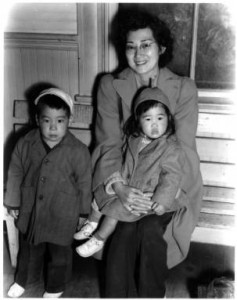Memoirs: An Annotated Bibliography
Compiled by Caitlin Shirts

Mother and children at Topaz camp
Editors’ Note: The memoir is an insightful literary form, not because it reveals in the words of the nineteenth-century German historian Leopold von Ranke “what actually happened,” but because it blends history and memory, producing an intimate, often impressionistic account of the past. The memoirs compiled here, all previously published in the Utah Historical Quarterly, are excellent examples of this genre. These offerings give delightful and often surprising recollections of Utah from an earlier time, many recalled from childhood or adolescence.
Herbert Z. Lund, Jr., “The Skeleton in Grandpa’s Barn,” Utah Historical Quarterly 35 (Winter 1967): 31–36.
Lund tells the story of how the skeleton of an executed murderer came to be stored in his grandfather’s barn in Salt Lake City and then buried in the barnyard, alongside issues of LDS church publications.
Josephine Pace, “Kimberly as I Remember Her,” Utah Historical Quarterly 35 (Spring 1967): 112–20.
Pace returns to her childhood gold-boom home, now a ghost town, and remembers its varied inhabitants and the ways they dealt with their city’s transformation from frontier settlement to boomtown to, finally, abandoned town site.
Fawn M. Brodie, “Inflation Idyl: A Family Farm in Huntsville,” Utah Historical Quarterly 40 (Spring 1972): 112–21.
Brodie recalls the years of struggle on the family farm to pay off the mortgage. Her parents, Thomas Evans McKay and Fawn Brimhall, hung on tenaciously through the Great Depression and the New Deal, which lessened the debt but went against her father’s Republican spirit, until finally finding a way out.
Fae Decker Dix, “Never Change a Song,” Utah Historical Quarterly 44 (Summer 1976): 261–66.
In Dix’s retelling of one childhood event, her father, a “walking Bible,” finds a way to protest the softening of militant lyrics in Mormon hymns, which he feels disrespect the narrative of the church’s founding.
Helen Z. Papanikolas, “Growing Up Greek in Helper, Utah,” Utah Historical Quarterly 48 (Summer 1980): 244–60.
Papanikolas grew up in a tight-knit immigrant community in Carbon County. She recalls the area’s unwritten rules concerning relations between immigrant and religious groups, which expressed themselves in everyday ways that dictated school and social life as well as destructive ways including a Greek-led coal miners’ strike and a KKK campaign.
Yoshiko Uchida, “Topaz, City of Dust,” Utah Historical Quarterly 48 (Summer 1980): 234–43.
Uchida recollects her eight months confined to a concentration camp at Topaz in the Sevier Desert. She taught school while enduring unfinished shelters in the winter, inadequate educational tools and support, and the dusty desert wind.
Saline Hardee Fraser, compiled by Marianne Fraser, “One Long Day that Went on Forever,” Utah Historical Quarterly 48 (Fall 1980): 379–89.
Saline Fraser was thirteen years old when she lost her father and grandfather in a devastating series of explosions in Castle Gate Mine No. 2. In this remembrance, she details the community reactions to the breaking news of the disaster, the rescue efforts, and the identification of her father’s remains by his socks.
Dean R. Brimhall, “A Winter Acquaintance with Timpanogos,” Utah Historical Quarterly 49 (Fall 1981): 340–47.
In winter 1916, Brimhall ascended Mount Timpanogos in snowshoes with LeGrand Hardy. His account, taken from his papers housed at the University of Utah, expresses his exhilaration in tackling the danger of ice and snow as well as in discovering new and beautiful facets of nature.
John Farnsworth Lund, “The Night Before Doomsday,” Utah Historical Quarterly 51 (Spring 1983): 154–61.
Lund remembers the day before Prohibition took effect, when Salt Lake City took on a carnival-like atmosphere and was filled with people creatively selling and consuming excess liquor.
Lea Nielson Lane, “Joe the Fish Lake Guide,” Utah Historical Quarterly 52 (Spring 1984): 158–64.
Lane’s father, Joe Nielson, hung out his shingle as a fishing guide at Fish Lake for forty-five years. In this fond tribute, she recalls, among other things, Nielson making sure his clients—including a movie star—caught the fish they wanted, filling the tires in his Model T radiator with wheat to prevent blowouts, and rescuing her from a dangerous boating accident.
Irene Stoof Pearmain, “The Memory Box,” Utah Historical Quarterly 52 (Fall 1984): 389–92.
Pearmain recalls her childhood as a daughter of German immigrants to Utah. Feeling isolated from her schoolmates by her cultural background, she nevertheless took joy in the strength of the close-knit German immigrant community and her family’s traditional holiday celebrations.
John Farnsworth Lund, “A Visit to the Champ’s House,” Utah Historical Quarterly 55 (Fall 1987): 335–39.
Lund recalls a day when, as a Boy Scout, he picked up food donations for the war effort from Jack Dempsey’s mother in Salt Lake City. His star-struck impressions of the famous fighter mingle with his story of the consequences of a misunderstanding: Mrs. Dempsey had requested a wagon to carry the goods, so he brought his little red wagon, not realizing she meant a horse-drawn wagon.
LaMar Petersen, “My Garden of Eden,” Utah Historical Quarterly 56 (Summer 1988): 236–49.
Petersen recalls everyday life during his childhood in Eden, Utah, recounting idyllic memories of his father’s general store, family life, visits to Ogden, and the neighborhood haunted house.
Robert S. Mikkelsen, “Growing Up Railroad: Remembering Echo City,” Utah Historical Quarterly 62 (Fall 1994): 349–62.
Mikkelsen grew up in Utah’s oldest railroad town, Echo City. He recalls how the railroad permeated his life, providing small town boys with work and livelihood, brushes with celebrity, and the detritus of train yards that became the basis for invented games.
Max E. Robinson, “A Trip with the Mail,” Utah Historical Quarterly 71 (Spring 2003): 165–77.
Robinson recalls one instance of traveling by horse-drawn wagon with his father and brother to deliver mail along the rough Old State Route 24.

